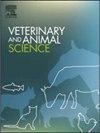印楝和姜黄的协同作用提高了肉仔鸡的饲料效率和胸肌中ω-6脂肪酸的含量
IF 1.9
Q2 AGRICULTURE, DAIRY & ANIMAL SCIENCE
引用次数: 0
摘要
本研究旨在探讨印楝和姜黄的协同作用,以解决肉仔鸡胸肌中饲料转化率不理想和ω-6脂肪酸富集不足的问题。试验选用288只罗斯-308雄性肉鸡,采用2 × 3全区设计(2种不同植物化学成分,即籼稻和龙花,在基础饲粮中分别占0、0.063和0.125%)的因子组合。测定末活重(FLW)、平均日采食量(ADFI)、平均日增重(ADG)、饲料系数(FCR)、胴体特性、心肺形态、血液生化指标、肠道形态、回肠营养物质消化率、胫骨形态、肉品质和FA谱。结果表明,添加籼稻叶粕(AILM)可提高6.0%的FCR (P <;胫骨钙含量为35.9% (P = 0.007),粗蛋白质消化率为9.6% (P <;0.001),以14.9% FLW为代价(P <;0.001), ADFI为20.6% (P <;0.001),平均日增重15.1% (P <;0.001),右心室与总心室比16.0% (P = 0.022)。因此,龙骨粉(CLP)提高了2.1%的FCR (P = 0.021),而FLW提高了5.9% (P = 0.031), ADFI提高了7.6% (P <;0.001)和5.3% ADG (P = 0.017)。AILM大幅增加了52.4%的UFA (P <;0.001)、58.2%的MUFA (P = 0.005)、38.7%的∑PUFA (P = 0.046)、41.7%的∑ω-6 fa (P = 0.013)和24.3%的∑SFA (P <;0.001)。CLP提高了8.1%的∑UFA (P = 0.022)、21.6%的∑PUFA (P = 0.015)、22.4%的∑ω-6 fa (P = 0.033),降低了4.3%的∑SFA (P = 0.031)。AILM和CLP相互作用使∑UFA增加35.3% (P = 0.003),∑SFA降低21.2% (P = 0.008)。由此可见,在不影响肉鸡肠道形态和血液生化指标的情况下,印度曲菌和长曲菌可显著提高肉鸡的饲料效率和肉品质。本文章由计算机程序翻译,如有差异,请以英文原文为准。
Synergistic interplay of Azadirachta indica and Curcuma longa improves feed efficiency and ω-6 fatty acid content in the breast muscle of broiler chicken
The study explores synergistic interplay of Azadirachta indica and Curcuma longa to address the current gap of suboptimal feed conversion ratio and inadequate enrichment of ω-6 fatty acids (FAs) in the breast muscle of the broiler chicken. Total 288 Ross-308 male broiler chicks were randomly distributed in a complete block design at 2 × 3 (Two different phytochemicals, i.e., A. indica, and C. longa at three different levels, i.e., 0, 0.063, and 0.125 % of the basal diet) factorial arrangement. Final live weight (FLW), average daily feed intake (ADFI), average daily gain (ADG), feed conversion ratio (FCR), carcass characteristics, cardio-pulmonary morphometry, haemato-biochemical indices, gut morphology, ileal nutrient digestibility, tibia morphometry, meat quality and FA profile were measured. Results indicated that, supplementation of A. indica leaf meal (AILM) improved 6.0 % FCR (P < 0.001), 35.9 % tibia calcium content (P = 0.007) and 9.6 % of the digestibility of CP (P < 0.001) at the expense of 14.9 % FLW (P < 0.001), 20.6 % ADFI (P < 0.001), 15.1 % ADG (P < 0.001), and 16.0 % right to total ventricular ratio (P = 0.022). Accordingly, C. longa powder (CLP) improved 2.1 % FCR (P = 0.021) at the expense of 5.9 % FLW (P = 0.031), 7.6 % ADFI (P < 0.001) and 5.3 % ADG (P = 0.017). The AILM substantially increased 52.4 % UFA (P < 0.001), 58.2 % MUFA (P = 0.005), 38.7 % ∑PUFA (P = 0.046), 41.7 % ∑ω-6 FAs (P = 0.013) and decreased 24.3 % ∑SFA (P < 0.001). Similarly, the CLP increased 8.1 % ∑UFA (P = 0.022), 21.6 % ∑PUFA (P = 0.015), 22.4 % ∑ω-6 FAs (P = 0.033) and decreased 4.3 % ∑SFA (P = 0.031). The AILM and CLP interacted to increase 35.3 % ∑UFA (P = 0.003) and to decrease 21.2 % ∑SFA (P = 0.008). It was concluded that A. indica and C. longa concomitantly improved FCR and meat quality without affecting gut morphology and haemato-biochemical indices of the broiler chicken.
求助全文
通过发布文献求助,成功后即可免费获取论文全文。
去求助
来源期刊

Veterinary and Animal Science
Veterinary-Veterinary (all)
CiteScore
3.50
自引率
0.00%
发文量
43
审稿时长
47 days
 求助内容:
求助内容: 应助结果提醒方式:
应助结果提醒方式:


